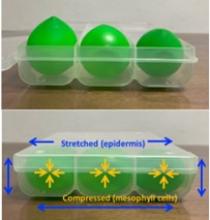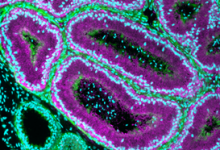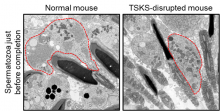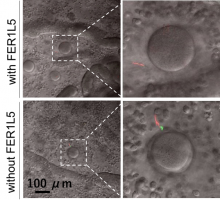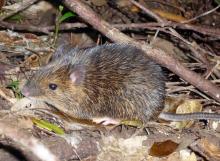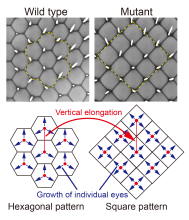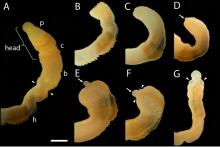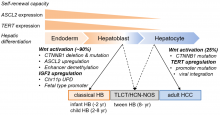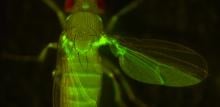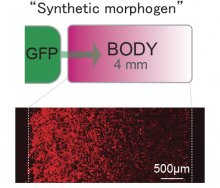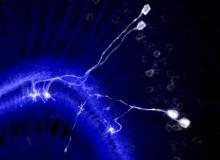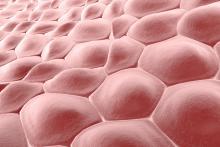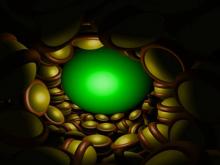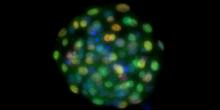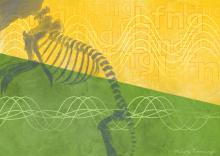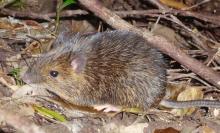Biology Developmental biology
News
17 May 2023
A research group led by Osaka University has found that plant cells may be able to detect mechanical forces to determine their own position within the leaf—whether they are on the surface or in the inner tissues—and therefore differentiate into appropriate cell types after damage. These findings reveal how plants regenerate the correct type of tissues when damaged, and may improve our understanding of the mechanisms underlying the high regeneration potential of plants.
11 May 2023
Researchers from Osaka University identified a new protein, NICOL, and described its crucial role in the maturation of sperm, which itself is necessary for male fertility. Mice who lacked this protein were sterile. Such a discovery may have implications for the development of male contraceptives.
13 Mar 2023
Researchers from Osaka University identified the role of a protein known as testis-specific kinase substrate (TSKS) in the process of spermiation, the release of mature sperm. Analysis of a gene-modified mouse model in which TSKS is disrupted revealed that TSKS is necessary for sperm to eliminate cytoplasm and become streamlined. These findings may lead to the development of diagnostic tests and male contraceptives.
25 Jan 2023
Researchers from Osaka University have identified a protein, FER1L5, that is essential for sperm to acquire fertilizing ability. Sperm from mice lacking this protein were unable to undergo the “acrosome reaction”, which releases molecules that facilitate fertilization, resulting in impaired male fertility. As FER1L5 is also present in human sperm, this work may lead to new diagnostic methods and treatments for male infertility in humans.
28 Nov 2022
The Sox9 gene is upregulated in the absence of sex-determining Y chromosome and Sry gene in Amami spiny rat.
08 Sep 2022
Researchers study sex-determination in birds using primordial germ cells and RNA-sequencing analysis.
20 Apr 2022
Tile patterns in which the same shape is laid out without gaps are found in the compound eyes of insects. Hexagonal tile patterns are common while shrimp eyes have a square pattern. We investigated tile pattern formation using Drosophila and revealed that the compound eye tile pattern is controlled by a geometrical division mechanism, Voronoi tessellation, in addition to physical constraints determined by the combination of the regular distribution and growth of the individual eyes.
15 Feb 2022
Better understanding of regeneration in hemichordates may eventually lead to advances in reparative medicine
04 Feb 2022
Rice has long been a staple food for more than half the global population. The United Nations even declared 2004 the International Year of Rice to raise awareness and encourage action to protect and advance the crop for a rapidly growing population. The genetic guidance rice uses to grow and reproduce, however, is still not fully understood. Now, a research team based in Japan is learning more, including how critical one gene is for the plant to develop grains of rice, which serve as both seeds and food.
16 Sep 2021
Genetic and epigenetic profiling of hundreds of hepatoblastoma tumors have revealed many of its secrets, long unknown to those researching and treating what is the most common type of liver tumor in children.
06 Sep 2021
Neuroscientists develop a new approach to better understand the neural mechanism underlying deductive and inductive reasoning
21 Jan 2021
A team of scientists in Japan has developed a novel method to induce stem cell generation from the blood samples of dogs. Through this technique, the scientists hope to advance regenerative therapies in veterinary medicine. This would mean that, in the near future, veterinarians might be able to reverse conditions in dogs that were previously thought incurable.
24 Dec 2020
Tohoku University scientists have, for the first time, provided experimental evidence that cell stickiness helps them stay sorted within correct compartments during development. How tightly cells clump together, known as cell adhesion, appears to be enabled by a protein better known for its role in the immune system. The findings were detailed in the journal Nature Communications.
20 Oct 2020
Researchers at Kanazawa University and University of California, San Francisco report in Science that arbitrary proteins, when combined with anchoring and receptor proteins, can work as a signaling protein “morphogen” capable of engineered spatial patterning.
07 Sep 2020
Researchers at Kanazawa University report in Nature Communications the discovery that in the developing fly brain, neurons stemming from the same parent cell experience repulsion. This lineage-dependent repulsion is regulated by a protein known as Dscam1.
20 Jun 2020
Researchers at Kanazawa University report in the Biophysical Journal that the process of cell removal from an epithelial layer follows from an inherent mechanical instability. Moreover, the forces generated by an extruding cell can drive the extrusion of other cells in a particular direction.
12 May 2020
In a recent study published in Molecular Cell, researchers at Kanazawa University report the role of cellular structures called PML bodies in regulating gene function
07 Feb 2020
A calf was born from an embryo lacking cells which form a large part of the placenta, providing new insight into the regenerative capacity of mammalian embryos.
08 Jan 2020
Researchers observe a key gene during embryonic development in single live mouse cells for the first time, providing insight about how the precise timing of development is controlled.
31 Jan 2019
A look at the brains of an endangered spiny rat off the coast of Japan by University of Missouri (MU) Bond Life Sciences Center scientist Cheryl Rosenfeld could illuminate the subtle genetic influences that stimulate a mammal’s cells to develop as male versus female in the absence of a Y chromosome.
Events
Sorry, nothing coming up for this discipline
Researchers
Professor Gail Tripp is a neurobiologist who established the OIST Children’s Research Center to undertake research on the nature, etiology and management of ADHD with English and Japanese speaking children and families.
Toru Kondo is Professor of the Division of Stem Cell Biology at the Institute for Genetic Medicine, Hokkaido University.
Giants in history
Sorry, nothing coming up for this discipline



